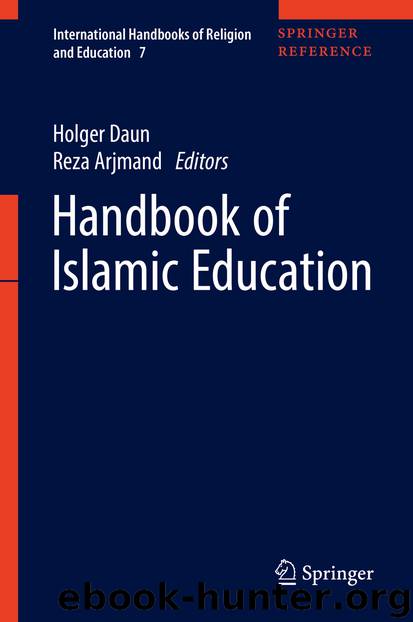Handbook of Islamic Education by Holger Daun & Reza Arjmand

Author:Holger Daun & Reza Arjmand
Language: eng
Format: epub
Publisher: Springer International Publishing, Cham
Conclusion: Beyond Islamic Children’s Literature
As pointed out in much literary theory, a defining quality of all children’s literature, whether secular or confessional, is its dual literary-pedagogic nature. It is meaningless to separate its literary and pedagogic elements (Nodelman 1988, 2000). In this sense, children’s literature provides “a specific semiosphere, or system of signs, which is heavily stratified and emerges and develops in interaction with mainstream literature” (Nikolajeva 1996: 7). Children’s literature has always reflected the cultural history of adults (Rhedin 1992: 21 f.). And as elaborated by Karimi and Gruber (2012: 290), discussing the image of the child in the Middle East, the study of children’s culture is “fundamental in enhancing our understanding of the implicit and explicit meanings of not only the condition of childhood but also the way in which power structures operate /.../.” However, children’s literature cannot be understood only in terms of a passive reflection of political, religious, or sociocultural values, but should be thought of as “one of the central means through which we regulate our relationship to language and images as such,” to quote Jaquline Rose’s (1984: 138f.) analysis of Peter Pan.
In line with this, rather than understanding the examples discussed in this chapter as mere adaptations of new literary formats for the purposes of religious education, Islamic children’s literature provides an important mode for cultural negotiation in and of itself. Taken as a whole, this literature ambiguously balances between a defensive-exclusive and offensive-inclusive cultural stance.
On the one hand, the literature is employed as a defense of religious and moral principles in a sociocultural context defined as threatening and subversive. This is highlighted in the literature’s recurrent preoccupation with Islamic creed and ritual; the semiotic references to Islamic particularism through clothing codes, greeting phrases, and calligraphy; the topical preoccupation with individual moral, civic duty and modesty; the references to Islamic sacrosanct history; and the narrative contextualization of the stories in gendered, domestic space or the sphere of divinely created nature. And just as observed in normative Christian children’s literature from the first part of the twentieth century (Toijer-Nilsson 1976), Islamic children’s literature often depicts young Muslims as idealized precedents, of higher moral stature than adults. Another tendency is the depiction of Muslims as victims of various types of social or cultural ills, in face of which Islam is mobilized as a safety mechanism, whether in detective stories, moral tales of virtuous social agency, or nonfiction about proper ethics. In all these aspects, Islamic children’s literature produced in response to diasporic needs and concerns essentially reproduces literary patterns in the Arab and/or Muslim world at large.
Precisely such tendencies are however increasingly called into question in internal Muslim debates about children’s literature. In a piece on the market of Islamic children’s books, the Islamic-feminist blogger “wood turtle” strongly objects to the traditional gender roles, the general preachiness, and the (most often archaic) Arabian setting of the bulk of this literature:Books intending to teach 5 years olds how to make ritual ablutions before prayer, or encouraging them
Download
This site does not store any files on its server. We only index and link to content provided by other sites. Please contact the content providers to delete copyright contents if any and email us, we'll remove relevant links or contents immediately.
The Art of Coaching Workbook by Elena Aguilar(51002)
Trainspotting by Irvine Welsh(21522)
Twilight of the Idols With the Antichrist and Ecce Homo by Friedrich Nietzsche(18510)
Fangirl by Rainbow Rowell(9108)
Periodization Training for Sports by Tudor Bompa(8174)
Change Your Questions, Change Your Life by Marilee Adams(7641)
This Is How You Lose Her by Junot Diaz(6803)
Asking the Right Questions: A Guide to Critical Thinking by M. Neil Browne & Stuart M. Keeley(5655)
Grit by Angela Duckworth(5525)
Red Sparrow by Jason Matthews(5392)
Paper Towns by Green John(5093)
Room 212 by Kate Stewart(5041)
Ken Follett - World without end by Ken Follett(4647)
Housekeeping by Marilynne Robinson(4349)
The Sports Rules Book by Human Kinetics(4302)
Double Down (Diary of a Wimpy Kid Book 11) by Jeff Kinney(4209)
Papillon (English) by Henri Charrière(4199)
The Motorcycle Diaries by Ernesto Che Guevara(4018)
Exercise Technique Manual for Resistance Training by National Strength & Conditioning Association(3963)
